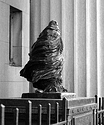I haven't read the whole thread, so apologies if I reiterate some already-given advice

First, extending print development time used to be a useful tool with some graded papers for squeezing a bit more contrast out of a particular grade when switching to the next higher contrast grade would be too much, i.e., to get an intermediate contrast. This isn't really needed with modern VC papers, especially if you're using a continuously-variable dichroic color head or the like, since intermediate contrast is easier to achieve by simply dialing in more filtration. Even with half-step filters, there is more contrast choice than with graded papers.
Second, if you're not getting deep blacks with standard development times (i.e., 2-3 minutes with Dektol, Bromophen, etc. and less with some liquid concentrates), then you're not exposing correctly (or not choosing contrast correctly, or your negative is just so flat that even a #5 filter won't help). It is erroneous to think that extending development somehow increases print quality; you would be much better off exposing correctly at the right contrast setting and developing "normally."
Third, with most modern papers, extending development does not result in a contrast change, rather it just increases the paper's effective speed, just like exposing a tiny bit more would do. That's what I use extended development for; making small changes to print exposure. Often it's easier to just extend development than to add a second or two to the exposure time so I don't have to change my dodging and burning routine that I've already practiced and got down pat. Adding a minute or even 30 seconds can make a noticeable difference in the final print. However, if I find I have to add 2 or more minutes of extra development, then it is always easier (and better) to change print exposure time.
Finally, you make a test strip to get started, and you should be developing it at your "standard" print developing time. If you want to make a change in development time later when refining your print, you don't have to make a new test strip. Whatever the case, you shouldn't be standardizing on extra-long development times. Not only is it unnecessary and won't deliver better results, but it wastes time. Sure, you need to develop long enough to get the full range of tones, but after a certain point, you're just adding overall density and risking fogging the whites. FWIW, my standard times in D-72 (Dektol) and ID-62 is 2.5 minutes.
Make your test strip, find your base exposure and make a "first print." Decide on what improvements, manipulations, changes you want to make (including exposure and contrast) and make a second print (unless a rather large contrast change is needed, then start over with a new test strip at the new contrast setting). Continue refining, including extending development to get a bit more overall density if that is more convenient than changing exposure, till you have a print that is a keeper.
Best,
Doremus





 Here's what it says on the Dektol package:
Here's what it says on the Dektol package:

